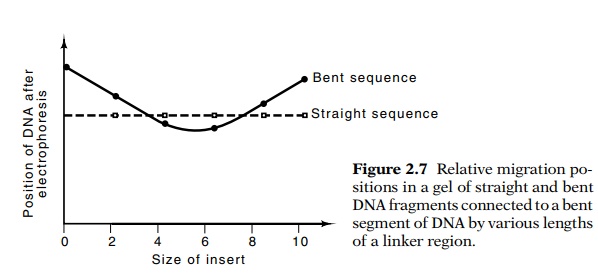Chapter: Genetics and Molecular Biology: Nucleic Acid and Chromosome Structure
Bent DNA Sequences
Bent DNA Sequences
If a series of small bends in DNA are added coherently, together they generate a significant bend. Most surprisingly, a short DNA fragment of several hundred base pairs containing such a bend migrates anomal-ously slowly in electrophoresis.

Such abnormally migrating fragments were recognized soon after DNA sequencing became possible, but some time passed before it was realized that the major contributor to bending is a run of three or four A’s. Significant bends can be generated by spacing several AAAATTT elements an average of 10 to 11 base pairs apart.

Figure
2.6 Determining whether a DNA segment
to be tested is straight orbent. Top, segment is straight and a five base
insertion generates no change in migration rate. Bottom, insertion changes the
migration rate if the segment is bent.
Bending of DNA is biologically important. Some
DNA-binding pro-teins bend DNA, and the natural bend of other sequences like
some origins of DNA replication appears to be essential. Many of the binding
sites of proteins are naturally bent, and the binding of the protein further
bends the DNA. Thus, the presence of a bend in the DNA helps the binding of a
protein which further bends the DNA.
The bending generated by a specific DNA sequence or
by the binding of a protein to a specific site can be tested even if the bend
is small. Suppose the DNA in question is connected to another segment of
“reference” DNA that is known to contain a bend. These bends may add as shown
in Fig. 2.6, or they may cancel. Now consider the consequences of adding two,
four, six, eight, and ten base pairs between the test and reference regions. As
the additional spacing DNA is added, one segment is rotated with respect to the
other. At some point in the process the two bends are in the same direction and
add and the migration rate of the

Figure
2.7 Relative migration po-sitions in
a gel of straight and bent DNA fragments connected to a bent segment of DNA by
various lengths of a linker region.
segment will be low. At another position of
relative rotation, the two bends cancel one another and the migration rate of
the DNA is faster. Plotting the migration rate as a function of the relative
rotation or spacer DNA added (Fig. 2.7) can prove the existence of a bend, as
well as determine its direction and magnitude.
Related Topics